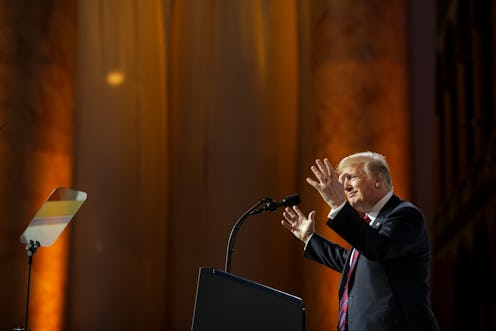News
Being Asian In America Was Always Complicated. Trump Made It Worse.

The Asian-Pacific American (APA) experience comes in myriad forms, and chief among them is the constant state of being two things at once. You straddle two worlds: one of your Asian heritage, the other your American upbringing. You are always both and neither.
This particular condition has long been dicey, but now it feels exceptionally turbulent. It is 2018 and we’re in the age of Trump — the far-reaching consequences of which we haven’t yet begun to know. Already, his acolytes are wallowing in the fresh fascism of the alt-right. It is a perilous time to be othered.
"Asian Pacific American Heritage Month in 2018 feels especially poignant."
Take race, for example. Tensions are high and racism is on everyone’s lips, whether they’re highlighting, denying, or justifying its existence. In the U.S., Blacks, Latinx immigrants, and Muslims are scorching under the glare of a terrible, withering spotlight, cast by powerful groups desperate to maintain their primacy. POC’s rights and humanity are somehow topics of debate instead of inviolable premises.
Notice anyone missing? While this terrifying saga plays out, APAs are swept to the side, quietly concealed by the shadows of that punishing spotlight.
Invisibility is old hat to the APA. We have the reputation of being quiet, inscrutable, and mild-mannered. We’re perpetual foreigners, forever on the outskirts of American life. Above all, we’re erased from the visual landscape time and time again, literally rendered invisible in popular media. It seems we cannot stand in for ourselves, even in our own narratives.
If you’re APA, you’re aware that the experience of being made unseen has been a long-standing point of pain. You’re likely also aware that, through a perverse unfolding of history, this mass invisibility has recently acquired a striking silver lining. As a group, we’re subtly coasting by, largely absent from the national discourse on race and oppression.
Make no mistake, APAs have suffered at the hands of America’s hegemony. We’ve been individually targeted; experienced systemic discrimination; been dehumanized en masse. Lately, though, those memories seem distant enough to grant the appearance of safety. We’ve assimilated to the best of our ability. We’re permitted enough that our presence goes unnoticed. Depending on who you ask, APAs are a little bit oppressed, or a little bit the oppressor; some of both, but mostly neither.
"The old dilemma remains: Who sees us? New dilemmas rise: How do we see ourselves and those not us? "
Being a member of a largely inconspicuous and neglected group at this particular moment in history produces a knotty relief in me, because with that relief comes shame. On one hand, I am grateful to be faceless and voiceless, so that my enemy may not see or hear me. On the other, I recognize the selfishness and solipsism at work in this gratitude. Once again, the familiar sense of being caught between poles, of embodying two things at once, snaps into place.
This isn’t a true relief. It’s an animal one, felt only in the body. It’s the temporary relief of a hare ensconced in tall grass, every muscle and tendon spring-loaded and ready to fire at the first sign of the wolf.
The slightest change in the political breeze could burn our grass down, expand the spotlight, make us dangerously seen.
As such, Asian Pacific American Heritage Month in 2018 feels especially poignant. I’m called to celebrate and pay tribute, but I must also navigate the maze of racial identity, belonging, and justice in America. The old dilemma remains: Who sees us? New dilemmas rise: How do we see ourselves and those not us?
The complexity of being APA is more salient and complicated than ever, which seems apropos. How could it be any other way?